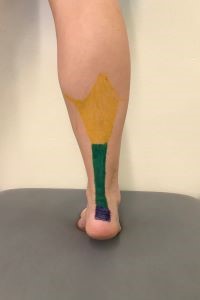The Achilles tendon is the biggest and strongest tendon in the human body. Achilles tendinopathy is a condition that can cause pain, swelling, stiffness and weakness of the Achilles tendon. It is a very common injury reported in runners, however, it is not exclusive to this population as people who have a more sedentary lifestyle will also suffer from it.
Symptoms of Achilles Tendinopathy
Pain generally tends to be worse in the morning, or during and after exercise. Some swelling and/or pain can occur around the tendon and calf area – most often in the areas shown below. The tendon may be very tender to touch and you may have increased discomfort wearing shoes that press against it.

The blue coloured area is the insertion point of the the tendon into the heel bone and the green coloured area is roughly the tendon itself with the yellow area the musculotendinous junction
Causes of Achilles Tendinopathy
The reasons for developing Achilles tendinopathy are varied but there are some common factors that seem to be important. The research consistently shows that reduced strength and endurance in the calf muscles is a major factor in developing Achilles tendinopathy. Also, being overweight will add more stress to the already struggling tendon. Footwear choice is important as the wrong shoes may aggravate the problem.
Research papers for further reading
Exercises and support
Treatment of Achilles tendinopathy commonly involves loading based exercises. This basically means exercises for the affected muscle/tendon unit with the aim that it improves strength and endurance and reduces the symptoms. Read a recent article in the British Journal of Sports Medicine around treatment.
Please don’t expect things to improve overnight though. It can take time for the tendon and muscles to adapt and improve. You may also find heel raises are useful to reduce the stress on the Achilles tendon while you are doing the rehabilitation, however, if they are uncomfortable, causing an increase in pain or other any other issues, then please remove them.
The video below demonstrates a range exercises that might help in the initial stages. There are 7 exercises in total. Numbers 1-4 relate more to problems with the Achilles Tendon, however, you may find the others useful too.
More advanced/progressive loading exercises
As the initial exercises become easier and less painful, it is important to progress and make the rehabilitation more challenging in order to improve the strength and endurance of the muscle/tendon unit. This progression is vital to ensure that the muscles and tendon are capable of coping with whatever activity you want to return to. The video below shows 5 videos that will take you through this progression.
Please make sure that you are comfortable and ready before making the step up to more challenging rehabilitation, and if in doubt, stay with the current plan until you are.
Please note: If you do not see any sign of improvement after 6 – 8 weeks of following the advice and exercises, please phone 0141 347 8909 for more advice and support.
